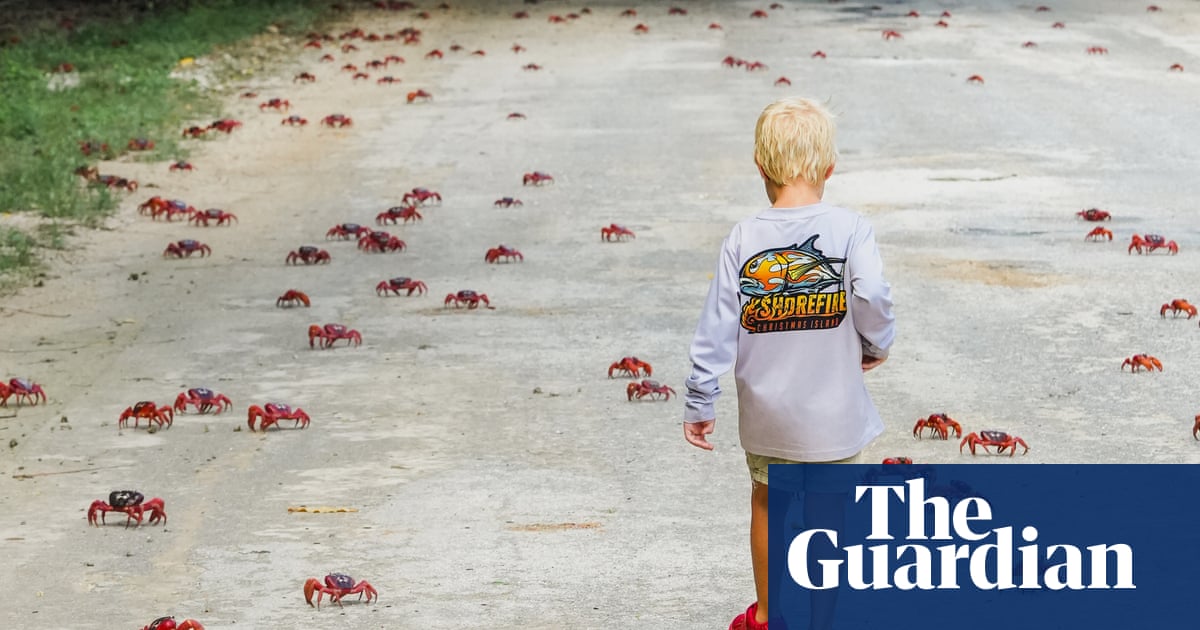Christmas Island’s red crabs begin their famed annual migration as authorities report progress to control pests threatening the charismatic crustaceans.
More than 100 million red crabs making their annual trek from Christmas Island’s rainforest to the coast are creating a migration spectacle that occupies countless bucket lists.
Their dominance of the landscape is an eye-catching phenomenon loved by tourists and treasured by residents.
For the island’s conservationists, it’s a reassuring sight.
The annual migration creates plenty of work for park rangers, who use rakes to keep them clear of the busiest roads. Photograph: AP
Brendon Tiernan, Christmas Island National Park’s senior field program co-ordinator for threatened species programs, said the war had not been won against the yellow ant invaders that threatened the red crabs.
“But we’ve had a significant impact,” he said.
Malaysian micro-wasps were brought in by scientists in 2016 to target a preferred food source of the ants.
Sign up: AU Breaking News email
They’ve helped manage the pests, which are highly territorial and spray formic acid on passing crabs, dehydrating and eventually killing them.
Tiernan said the tiny winged bio-control agents had done a “fantastic job” in suppressing the lac scale insect, the symbiotic pest species that produces the honeydew substance eaten by the ants.
“We haven’t won the war,” he said, with ant colonies tapping into other food sources.
A street sign warning of caution when driving around crabs. Photograph: John Pryke/AAP
Before the wasp’s introduction, it was estimated roughly two-thirds of the crab population was decimated throughout the early 2000s into the mid-2010s.
Fast-forward to 2025 and red crab numbers could be breaching the 180 million mark – a phenomenal recovery in just 10 years, Tiernan said.
Bumper years for returning baby crabs have further helped boost numbers.
It’s not clear why so many crabs returned in those years however, with eggs at the mercy of currents and predators once left adrift in the ocean.
Christmas Island red crabs spend most of their lives on land, returning to the water every year to breed.
skip past newsletter promotion
Sign up to Breaking News Australia
Get the most important news as it breaks
Privacy Notice: Newsletters may contain information about charities, online ads, and content funded by outside parties. If you do not have an account, we will create a guest account for you on theguardian.com to send you this newsletter. You can complete full registration at any time. For more information about how we use your data see our Privacy Policy. We use Google reCaptcha to protect our website and the Google Privacy Policy and Terms of Service apply.
after newsletter promotion
Before the last quarter of the moon, females emerge from their burrows and release their eggs into the ocean.
Traffic jam! The migration is an eye-catching phenomenon loved by tourists and treasured by residents. Photograph: AP
Spawning typically occurs like clockwork in line with the lunar cycle, although the length of the migration can vary, triggered by the first heavy rains of the wet season, usually around October or November.
Migration started a little earlier than usual this year, which was expected due to a negative Indian Ocean Dipole and warmer-than-usual waters – ripe conditions for rainfall in the region.
It was not yet clear if and how climate change was impacting crabs or their migration patterns, although Mr Tiernan said the island was expected to experience more severe dry periods as global temperatures rose, accompanied by more intense downpours once they finally arrived.
The annual migration creates plenty of work for park rangers, who use rakes to keep them clear of the busiest roads.
Crab safety is taken seriously, with eco-hotel Swell Lodge’s owner, Chris Bray, developing a contraption to put on the front of vehicles to gently steer them out of harm’s way.
Bray said he was forced to develop the “crab mobile” to travel to and from the lodge, with other residents typically able to stick with cleared and drivable roads.
The design has changed little in the six years it has been in use.
“The most important thing was it had to be durable, basic, easy to make and repair, and had to work even on the pretty rough roads around here, following the contours even in an eroded four-wheel-drive track,” he said.
